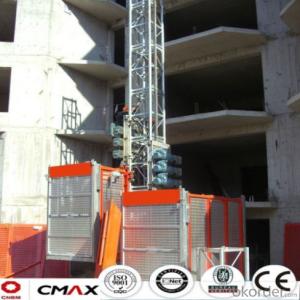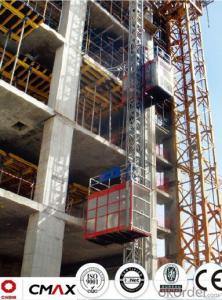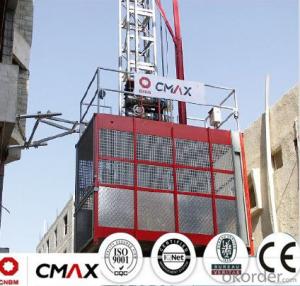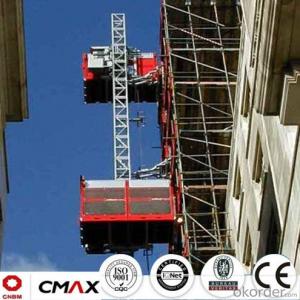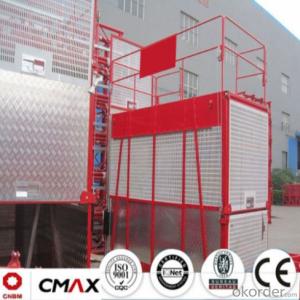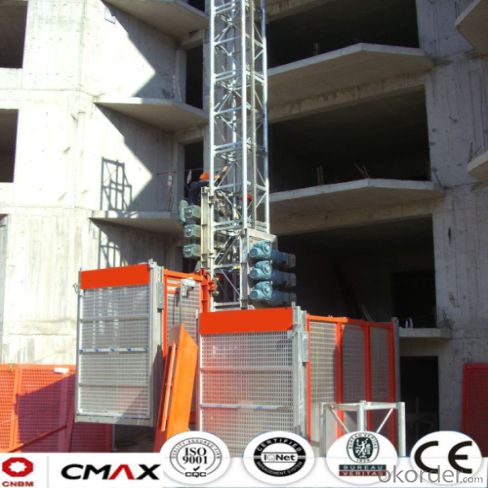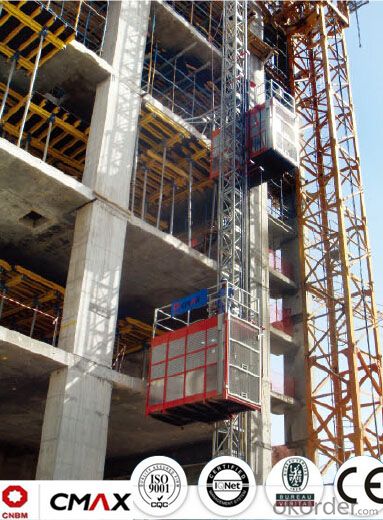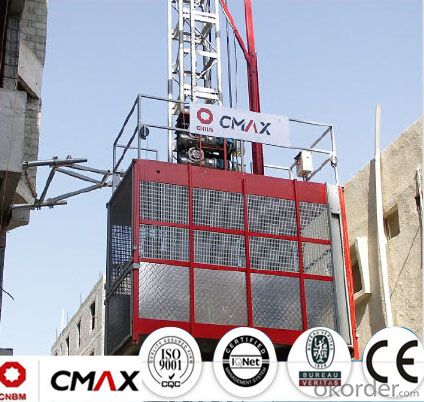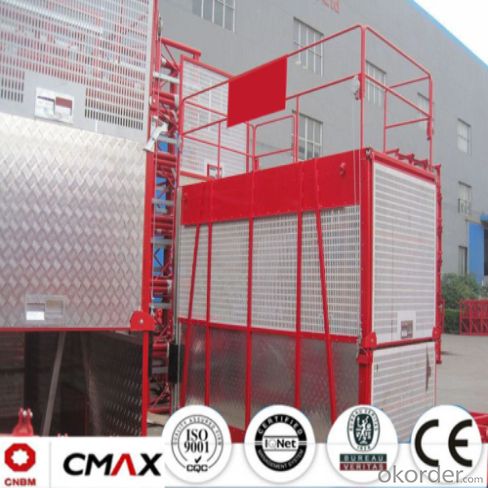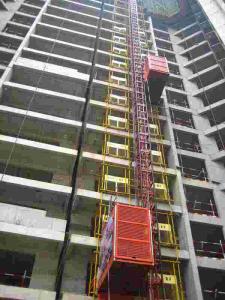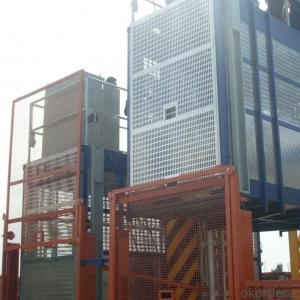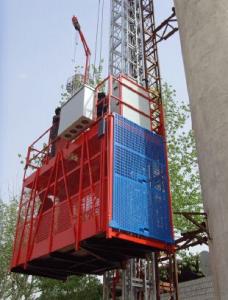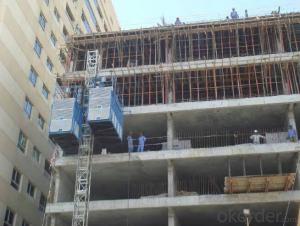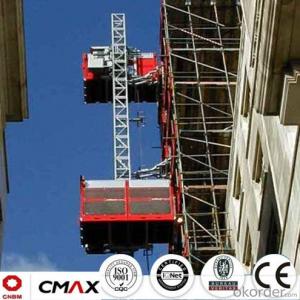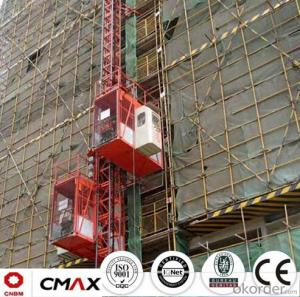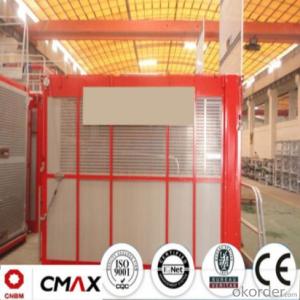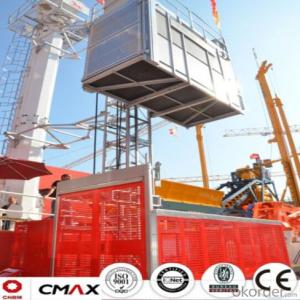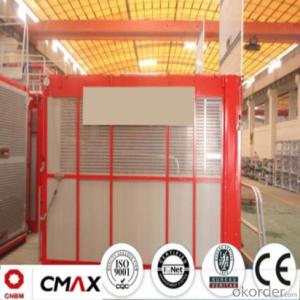Building Hoist European Standard Electric Spare Parts with 5ton Capacity
- Loading Port:
- China main port
- Payment Terms:
- TT OR LC
- Min Order Qty:
- 1 unit
- Supply Capability:
- 5 unit/month
OKorder Service Pledge
OKorder Financial Service
You Might Also Like
Structure of Building Hoist Description
1.The gearing select perfect bearing,strong cables and oil seal.
2.The electrical parts select products from famous world manufacturers for example Schneider,Siemens and LG.
3.The racks and pinion select advanced material and advanced technique,which enhance the life of all parts.
4.The steel structure adopted strong steel from famous native manufacturers.
5.The surface of the steel structure can adopt paint-spray,parkerizing baking finish or hot galvanizing processing depending on users requirement.
6.The cage can be made and decorated by aluminum molded board,punched-plate or figured aluminum board.
Packaging & Delivery of Building Hoist
Packaging: nude and wooded box Delivery: 25-30days
Mains Parts of Building Hoist
1.The steel structure for example the mast, tie in and cabin ,could be all spay-painted and hot galvanized. Mast section is made with high quality Q345B which is the top standared in China.
2.Electrical parts are all adopted with Schneider , Siemens and other famous brands.
3.The electrical system can be selected with the normal control method and VVVF+PLC control way. Inverter we selected is from Schneider. Yaskawa or other world renowned brand.
4.Cabin exit door select ramping type. The ramping door looks like a bridge between the construction hoist and construction building.
5.The cabin floor is made from 3MM thickness steel riffled board(Hot dip galvanized), and 15MM thickness wooden board which can reduce the vibration and deformation a lot.
6.Driving unit is adopted the products from ZHANGJIANG and other reputed maker, or from SEW, NORD.
7.Safety system is mainly composed of electrical motor braking, anti-drop safety device, top & bottom limit switches, top & bottom 3-phase switches, door limit switches, buffer device and over-load protection. The system aims to ensure the hoist are running safely.
8.Qualification: CE, ISO9001:2008 and etc.
9.The long-term operation of CMAX building hoists testifies CMAX hoist is working performance is stable.
Building Hoist Images



Building Hoist Specification

FAQ of Building Hosit
Q: What is the building hoist main purpose?
A: Building hoist equipped with double or single cabin to transport the materials and labors up and down. It's the ideal construction equipment for vertical transportation in the field of construction.
Q: What is the main structure of building hoist?
A: The P/M construction hoist mainly contains metal structure, driving system, electrical control system, cable guide & protection system, electrical top crane and safety device.
Q: What is the meaning of the building hoist’s code?
A: Take SC200/200 for example: “SC” stands for rack and pinion hoist, “200/200” stands for double cage and capacity is 2 tons per cage. “SC200” stands for single cage and capacity is 2 tons.
Q: What is the dimension of the cage?
A: Normally the cage dimension is 3X1.5X2.5M (L/W/H) for 2t type hoist. Details should be checked according to our
quotation sheet. Also, the size can be customized according to the factual site condition. There are two doors (entrance& exit doors) for each cage, It can be produced as up & down sliding or ramping model for safety and convenience.
- Q: What fundamental specifications or conditions must be met to operate a building hoist with a hydraulic pump?
- <p>To use a hydraulic pump to power a building hoist, several basic requirements must be met: a reliable power source, a suitable hydraulic pump with the correct pressure and flow rate, a robust and leak-free hydraulic system, safety mechanisms such as pressure relief valves and emergency stop features, proper installation and maintenance procedures, and adherence to safety standards and regulations. Additionally, the pump should be compatible with the hoist's design and capable of providing the necessary force and speed for lifting operations. Regular inspections and maintenance are crucial to ensure the hoist operates safely and efficiently.</p>
- Q: Safe use of construction elevator
- 1, seek professional installation. 2, pay attention to safety when using, don't worry, because the elevator is not as fast as the elevator. 3, if there is a broken part, change it quickly, don't delay and feel free
- Q: How does the driver of the construction elevator do the search for a sudden power failure
- When the elevator in the operation of the midway stop due to power outages or other reasons, the manual can be decreased, the end of a motor brake electromagnet manual release slowly shake handshandle pull outward, slowly slide down the ladder cage, ladder cage fall shall not exceed the rated speed, manually drop must be conducted by professional maintenance personnel.
- Q: This question asks for the proper steps to install a building hoist, a device used in construction to lift materials and workers.
- <p>To install a building hoist correctly, follow these steps: 1) Ensure the site is suitable and inspect the hoist for any damages. 2) Assemble the hoist tower on a solid, level base. 3) Install the mast and guide rails according to the manufacturer's instructions. 4) Attach the hoist mechanism and cab, ensuring all connections are secure. 5) Conduct a thorough inspection and test the hoist's functionality. 6) Obtain necessary permits and inspections from local authorities. 7) Train operators on the safe use of the hoist. Always adhere to safety guidelines and manufacturer's specifications.</p>
- Q: 6 layer of brick and concrete construction project, have tower crane still need construction elevator?
- 6 floors of brick and concrete construction projects, tower cranes do not need construction elevator. Brick structure refers to the building of the wall of vertical bearing structure, column, etc. By using brick or block masonry, lateral load-bearing beam, reinforced concrete structure is adopted for floor, roof boarding, etc. In other words, the masonry structure is a small amount of reinforced concrete and most brick wall bearing structures. The masonry structure is a kind of hybrid structure, which is composed of brick wall and reinforced concrete beams. Suitable for small width and depth, room area is small, multilayer or low-rise buildings, for load bearing walls can't change, while the frame structure of wall body can be altered.
- Q: What are the key safety rules and regulations that must be followed when operating a building hoist?
- <p>Safety regulations for using a building hoist include ensuring that the hoist is inspected and certified by a qualified person before use. Operators must be trained and certified. The hoist should be used only for its intended purpose, and load limits must never be exceeded. Regular maintenance and checks are required to ensure the hoist remains in good working order. Safety devices such as limit switches and emergency stops must be operational. The hoist area should be kept clear of obstructions, and warning signs should be posted. Personal protective equipment (PPE) must be worn by operators and anyone in the vicinity. Overhead protection should be provided to prevent objects from falling onto the hoist. Compliance with local and national regulations is also crucial.</p>
- Q: Is it possible to replace a building hoist with an electric winch for the purpose of lifting materials or individuals?
- <p>While theoretically possible, using an electric winch instead of a building hoist for lifting materials or people is not recommended due to safety concerns and differences in design. Electric winches are typically designed for pulling or towing loads and may not have the necessary safety features, load capacity, or stability required for lifting operations in a construction setting. Building hoists are specifically engineered to lift heavy materials and personnel safely in vertical shafts or on the facade of a building. They are equipped with safety devices and are regulated for construction use, making them the appropriate choice for such tasks.</p>
- Q: Explain the key differences between electric and pneumatic lifting equipment in a few sentences.
- <p>Electric lifting equipment is powered by electricity and offers precise control, high efficiency, and is suitable for heavy-duty applications. Pneumatic lifting equipment, on the other hand, is powered by compressed air and is known for its simplicity, safety, and lower cost. It is often used in environments where electrical equipment might be hazardous, such as in the presence of flammable gases or dust. Electric systems can handle heavier loads and provide more precise control, while pneumatic systems are more resistant to overload and offer a fail-safe mechanism in case of air pressure loss.</p>
- Q: Is it possible to use a building hoist to lift various types of materials?
- <p>Yes, a building hoist can be used for lifting different materials. It is designed to handle a wide range of loads, from construction materials like bricks and cement to heavy equipment. However, it is crucial to ensure that the materials being lifted are within the hoist's weight capacity and that they are properly secured to prevent accidents. Always follow the manufacturer's guidelines and safety regulations when using a building hoist to lift various materials.</p>
- Q: This question asks whether a building hoist can be used in both indoor and outdoor construction settings.
- <p>Yes, a building hoist can be used both indoors and outdoors for construction work. These hoists are versatile and designed to facilitate the movement of materials and personnel in multi-story buildings. Outdoors, they are often used during the construction of high-rise buildings, while indoors, they can be used for the vertical transportation of materials in large structures like shopping malls or office buildings. It's important to ensure that the hoist is suitable for the specific conditions, such as weather resistance for outdoor use, and that safety protocols are strictly followed to prevent accidents.</p>
Send your message to us
Building Hoist European Standard Electric Spare Parts with 5ton Capacity
- Loading Port:
- China main port
- Payment Terms:
- TT OR LC
- Min Order Qty:
- 1 unit
- Supply Capability:
- 5 unit/month
OKorder Service Pledge
OKorder Financial Service
Similar products
Hot products
Hot Searches
Related keywords
